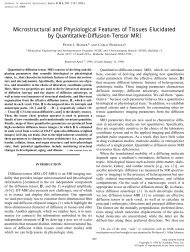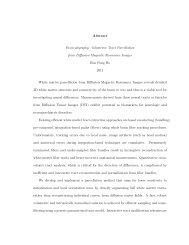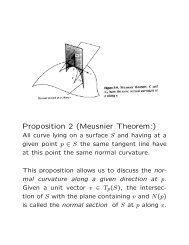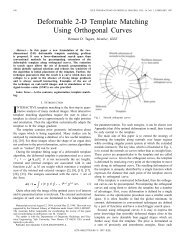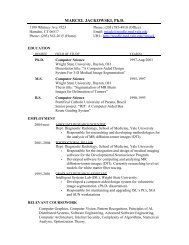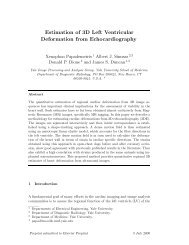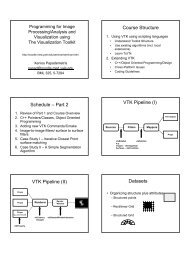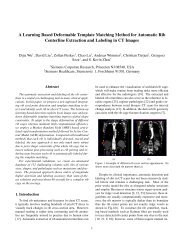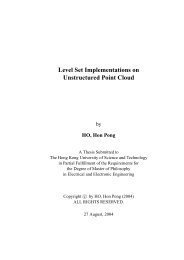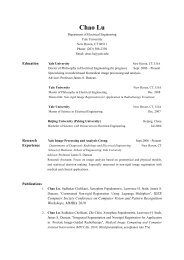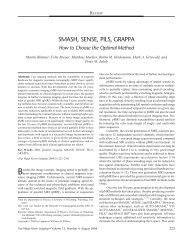Pulsed-field gradient nuclear magnetic resonance as a tool for ...
Pulsed-field gradient nuclear magnetic resonance as a tool for ...
Pulsed-field gradient nuclear magnetic resonance as a tool for ...
Create successful ePaper yourself
Turn your PDF publications into a flip-book with our unique Google optimized e-Paper software.
322<br />
PRICE<br />
² 2 Ž .: <br />
z . Further, using Eq. 33 , the apparent<br />
time-dependent diffusion coefficient can be obtained,<br />
i.e.,<br />
Ž . ² 2 Ž .: Ž . <br />
D z 2 97<br />
app<br />
from the low q limit of EŽ q, . . As might be<br />
expected, the time dependence of the apparent<br />
diffusion coefficient over observation time Ži.e.,<br />
. ² 2Ž .: 12<br />
, such that is finite but that z is less<br />
than the distance between the confinements,<br />
provides in<strong>for</strong>mation on the surface-to-volume ratio<br />
of the confining geometry see c<strong>as</strong>e Ž ii. in Fig.<br />
4 . Mitra and coworkers Ž 9698. derived the relationship<br />
4 S geo 12 12<br />
D Ž . app D 1 D <br />
3d' V<br />
<br />
98<br />
where d is the number of spatial dimensions and<br />
SgeoV is the surface-to-volume ratio. Thus, Dapp<br />
deviates from D approximately linearly with 12 .<br />
These surface effects have been nicely illustrated<br />
in a recent review by Callaghan and Coy Ž 14 . .<br />
The Validity of the Different Approaches<br />
In the third section we presented three approaches<br />
<strong>for</strong> calculating the effects of diffusion<br />
on the signal attenuation in the PFG experiment.<br />
The macroscopic approach provides analytical solutions<br />
but is mathematically tractable only <strong>for</strong><br />
free diffusion and <strong>for</strong> diffusion superimposed<br />
upon flow. We then presented the GPD and SGP<br />
approximations. It should be noted that these are<br />
not the only approximations available Že.g.,<br />
Refs.<br />
Ž 99, 100 ..<br />
In the c<strong>as</strong>e of free diffusion, the GPD<br />
approximation is valid and gives the same result<br />
<strong>as</strong> the macroscopic approach, while the SGP approximation<br />
gives the same result but in the limit<br />
of 0 <strong>as</strong> g. However, in chemical and<br />
biochemical systems Že.g.,<br />
cells, micelles, zeolites,<br />
etc. . , it is often the c<strong>as</strong>e that the diffusion of the<br />
probe species is restricted on the time scale of <br />
Ž see Free and Restricted Diffusion . , and to analyze<br />
the experimental data, the SGP or GPD<br />
approximation is normally used if the system is<br />
mathematically tractable. If the system is too<br />
complicated numerical methods must be resorted<br />
to.<br />
It is important to understand the implications<br />
of the approximations involved in the GPD and<br />
SGP approaches e.g., Refs. Ž 94, 101104 ..<br />
The<br />
validity of the GPD approach is determined by<br />
the validity of Eq. 57 .<br />
From the above discussion<br />
it w<strong>as</strong> seen that the Gaussian ph<strong>as</strong>e approximation<br />
is justified in the c<strong>as</strong>e of free diffusion.<br />
Consequently, it will also hold in the c<strong>as</strong>e of<br />
restricted diffusion when is so short that very<br />
few of the spins are affected by the boundary Ži.e.,<br />
1; see earlier text and Fig. 2 . , since the<br />
propagator describing the restricted diffusion Ži.e.,<br />
PŽ r ,r ,t.. 0 1 will reduce to that of the free diffusion<br />
c<strong>as</strong>e Ži.e., Eq. 27 . . Similarly, Neuman Ž 79.<br />
showed that when becomes so long that the<br />
probability of being at any position at the end of<br />
is independent of the starting position, the<br />
change in ph<strong>as</strong>e becomes independent of the<br />
ph<strong>as</strong>e distribution. From the central limit theorem<br />
Ž 65 . , the distribution of the sums of the<br />
ph<strong>as</strong>e changes becomes Gaussian. However, the<br />
en<strong>for</strong>cing of a Gaussian ph<strong>as</strong>e condition is a<br />
severe approximation and, <strong>as</strong> a consequence cannot<br />
yield interference effects Ž 105 . .<br />
In many experiments, particularly where the<br />
sample h<strong>as</strong> a short T2 relaxation time, which<br />
limits the value of in the PFG pulse sequence,<br />
it may be impossible to comply closely enough<br />
with the requirements <strong>for</strong> SGP approximation. In<br />
this c<strong>as</strong>e, the GPD is useful, since it accounts <strong>for</strong><br />
the finite length of the <strong>gradient</strong> pulse. However,<br />
the GPD approximation is exact only in the limit<br />
of free diffusion Ž i.e., R . ; that is, where the<br />
ph<strong>as</strong>e distribution is Gaussian, while the SGP<br />
equation is only strictly valid <strong>for</strong> infinitely small .<br />
Balinov et al. Ž 101. used computer simulations of<br />
Brownian motion to test the validity of the GPD<br />
and SGP approximations. They found that the<br />
GPD approximation solution <strong>for</strong> diffusion within<br />
a reflecting sphere Žsee Eq. 99 below. simulated<br />
the data very well in the limit of 1, fairly well<br />
<strong>for</strong> 1, and well <strong>for</strong> 1. In contr<strong>as</strong>t, the<br />
SGP solution described the data well <strong>for</strong> large<br />
values of and small <strong>gradient</strong> strengths. The<br />
results showed that at 1 the long time limit of<br />
the SGP equation Ži.e.,<br />
the attenuation h<strong>as</strong> become<br />
independent of . is already applicable<br />
Ž 101 . . Blees Ž 102. and others e.g., Ž 94, 105 .,<br />
using numerical simulations, considered the effects<br />
of finite on the SGP approximation solution<br />
ŽEq. 92. <strong>for</strong> spin diffusing between reflecting<br />
planes Ž Fig. 6 . . They found that <strong>as</strong> the<br />
duration of the <strong>gradient</strong> pulse becomes finite,<br />
the diffraction minima shift toward higher q. The<br />
higher-order minima were more affected than the<br />
first minimum.



